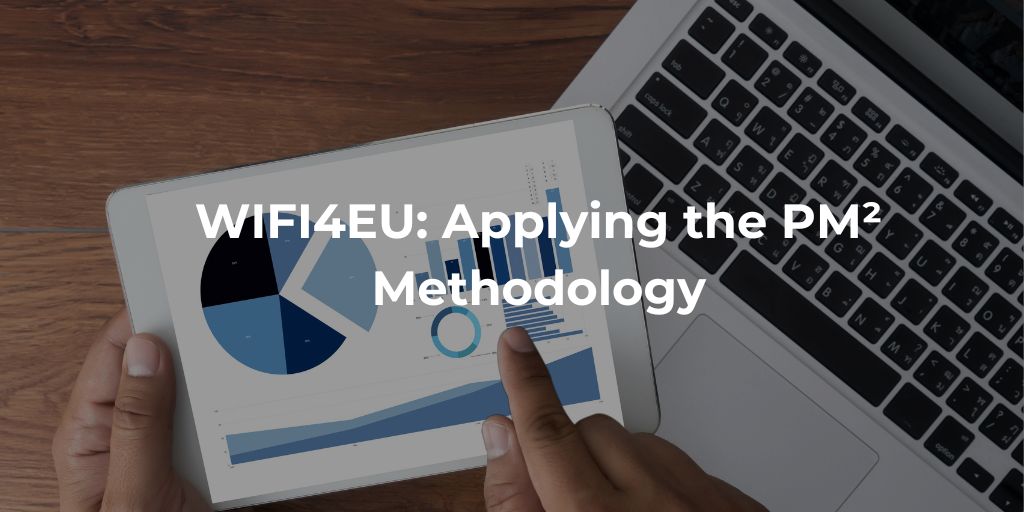The PM² Methodology is the official project management methodology of the European Commission. It is extremely versatile and can be customised to the needs of any industry or project. PM² practices allow Project Teams to maximise results and to deliver the best solutions and benefits to all stakeholders. The PM² Methodology is also easy to implement and can be used effectively by Project Managers with all levels of experience.
To better understand how PM² has been used in an international project, we have interviewed Marc Berghmans, Project Manager of WIFI4EU. We discussed the project’s impact and how Marc and his team applied the PM² methodology to achieve the best results.
WIFI4EU: a Case Study
The foundation of the project WIFI4EU was laid by Jean-Claude Juncker, the 12th president of the European Commission (from 2014 to 2019), when he stated the need to “equip every European village and every city with free wireless internet access around the main centres of public life – such as parks, squares, public buildings, libraries, health centres, and museums – by 2020”.
The idea was that everyone should benefit from Internet connectivity, regardless of location or income. To do so, the European Union allocated between 2018 and 2020 a budget of EUR 120 million to the WIFI4EU initiative with the goal of “promoting free Wi-Fi connectivity for citizens and visitors everywhere through Europe.”
In those years, the project achieved its mission of installing more than 90,000 WIFI4EU access points in over 7,000 municipalities all over Europe, providing citizens and visitors alike with free WIFI connection, allowing remote villages and cities to be better connected online and reducing the discrepancy between those who have access to the Internet and those who have not.
WIFI4EU: Applying the PM² Methodology
During our interview with Marc Berghmans, Project Manager of WIFI4EU, we discussed how the PM² Methodology was used to successfully deliver this international project. First of all, Marc highlighted the importance of customising the PM² Methodology to one’s environment and processes. This is usually one of the main challenges, because it requires a good understanding of what information is needed to maximise the methodology’s effectiveness, tailoring it to the project team’s needs.
Marc Berghmans also emphasised that a clear governance structure is essential in managing a project, and especially one that has a large scope. A clear governance structure delineates roles and responsibilities of all internal stakeholders, which helps define expectations and working relationships (who is doing what, who is responsible for each task). Without a clear governance, chaos will ensue.
Another essential aspect in successfully applying the PM² Methodology to one’s project is to always refer to the PM² Mindsets, the attitudes and behaviour that help project teams focus on what is essential to achieve their goals.
WIFI4EU: Risk Management with PM²
The application of PM² Practices and Mindsets, combined with the extended Project Management experience of Marc Berghmans and the competences of his team allowed the WIFI4EU Project to proceed without major challenges. However, one unexpected situation was linked to the online portal, from which the municipalities could apply to receive funds and search for suppliers – certified by the European Commission – that would handle the construction of the infrastructures needed to provide their city/region with WIFI connectivity. When they started testing, the municipalities had to go from their portal to the commission portal to provide valid documents and certifications, and then back to the original portal. The commission website received all the traffic from the WIFI4EU website, flagged it as suspicious and blocked it. Fortunately, the problem was quickly solved. This situation exemplifies how important testing is, because if the same problem happened on launch day the situation would have been much more problematic than it was during this test run.
Marc Berghmans provided us with more insights on the importance that PM² Risk Management Practices have in quickly and effectively overcoming any challenges during a project. He shared with us that the best moment to think about Risk Management Practices is during the kick-off meeting, a moment where everyone is still calm and can think rationally about how to handle a problematic situation.
During the meeting, it is also important to outline the communication process that will stay in place for the whole project (frequency, information shared in the reports, and roles involved).
Other than the standard practices, like keeping a risk log and updating it every month, it is important to define an “issue process”: How can we communicate about problems? What style of communication does management want? From emails, to chat, SMS, or direct calls: everything must be agreed beforehand to allow smooth handling of potential problems. Moreover, everyone should be able to bring up an issue.
Finally, it is important to think about what incidents/situations can have an impact (scope-wise, time-wise, or budget wise) on the project. It is also important to review risks regularly (e.g., monthly), because some risks may not be applicable at a certain stage of the project but can become important at a later stage.
All of what was mentioned is part of the overarching challenge of customising the PM² Methodology to the project and stakeholder’s needs.
If unexpected situations were to occur, it is important to refer to the governance structure to understand which roles can be involved in the solution of the problem. It is also essential to receive relevant information to make the necessary decisions that will solve the issue with minimum deviation from the original plan.
WIFI4EU: Lessons Learned
The most important “Lesson Learned” that Marc Berghmans, with his 30+ years of successful planning and coordination of large-scale projects, programmes, and business process improvements, shared with us is that two phases of a project are usually underestimated: Risk Management and Testing.
For him, Testing and Low Testing is something that should start as soon as the project starts. And test cases must be written down not by developers, but by the people who make the requirements, because they understand them best. Marc also stressed that Testing should always include actionable test-data. Starting early in the project allows the project team to understand if the requirements for testing are feasible and achievable, and gives the project a head-start.
Another important Lesson Learned is about communication and, especially, listening to each other: fully committing to listening to the other person, instead of starting to think about our answers a few words in, can open our minds to new solutions.
WIFI4EU: Actionable Steps to implement the PM² Methodology
We asked Marc which actionable steps he would suggest to a company that wants to efficiently implement the PM² Methodology in their projects, and his response highlighted the following main questions that management and project teams should always ask themselves:
- First of all, it is important to ask “Why do we want to use PM Square?”. Each company has different reasons for implementing it, maybe they have projects that do not do as well as they think they should, or they always go over budget, maybe the deliverables are never on time or it is unclear when the project should end.
- Secondly, Marc suggests that these companies write down the answer to these two questions: “What do we need?”, “What do we call a project?”. Marc himself asked these same questions to several institutions inside the European Commission to determine how to improve the way projects were managed.
- “What is the role of the project manager in our company? “Can they take the necessary steps to continue managing the project?”. Marc also shared with us that he has seen companies send all their project managers to training, get certified, but never actually implement the methodology in their projects. To correctly and effectively implement any project management methodology, its practices should be applied at all steps and in all activities of the company/ institution: processes will need to be changed, and steps and new tasks will have to be implemented.
After these preliminary questions, Marc identified these three questions that can help a company think about the actionable steps needed to implement the PM² Methodology into their activities:
- How are you going to implement it to make a plan?
- How are you going to explain the new processes to everyone in the company?
- Why are we doing this?
In all of this, the role held by management is extremely important. Marc remembers an old saying that perfectly encapsulates this sentiment “if you want to do it, the chief must speak”, that means that the CEO or someone important in the hierarchy has to back-up the introduction of the new project management methodology.
To speed up implementation, management must have a clear plan and must be able to communicate to all stakeholders. It is also important to remember that the correct implementation of a project management methodology takes time, it will not be done in three weeks, in most cases it takes around six months to a year.
Finally, it is important to understand what practices of the PM² Methodology the company wants to apply:
- What do we want to take from the methodology? What are the things that will be common in all projects?
- What about customization?
Companies that have a lot of projects can optimise their processes and speed up their implementation of the methodology by creating a Project Management Office (PMO). A PMO can follow up projects and take care of deliverables and outcomes.
Marc’s final advice is to take your time to do it. Create a structure, try it with one or two small pilot projects, and keep learning from each new project.
Why Should I Use PM²?
To end our interview we asked Marc Berghmans why a company or a professional should use the PM² Methodology in their projects.
He mentioned that the PM² Methodology is clear and easy to understand, with a guide that is around 100 pages. For every practice PM² has an open document template you can download in Word or Excel format, so that it can be immediately used. For each template there’s clear indications about what needs to be filled in for your project. And as part of the customisation process, you can always not use a template that does not apply to your current project.
PM², like other Project Management Methodologies, provides a common understanding of how to manage projects, with shared technical language and practices.
Finally, PM² is the official Project Management Methodology of the European Commission, thus it is ideal when working with public institutions all over Europe. Material for the different PM² programs (e.g., PM² Agile. PM² Portfolio Management, PM² Programme Management) is available online on the official PM² website.
If you want to learn about why PM² can be ideal for your next project, read our blog “5 Reasons to Fall in Love with PM²” written by our trainer Natacha Brenner. To learn more about how the PM² Methodology came to be, read our blog “The PM² Story”.
QRP International organises training courses on PM² Project Management methodology, If you want to learn more check our PM² website page or contact us!









